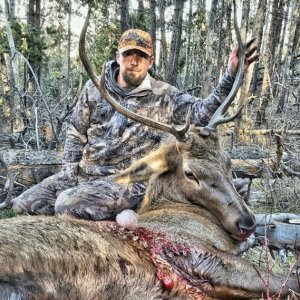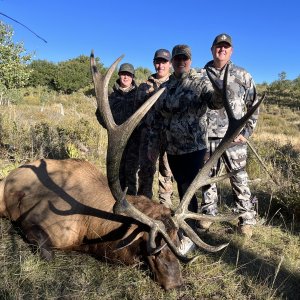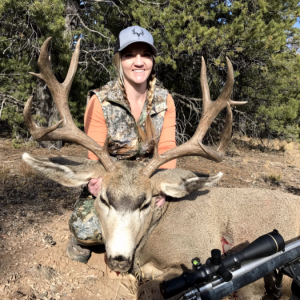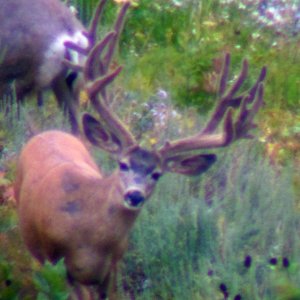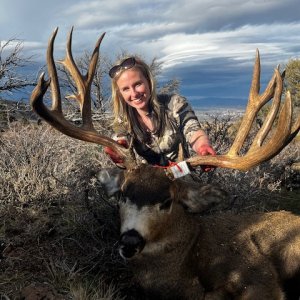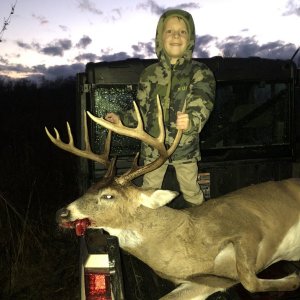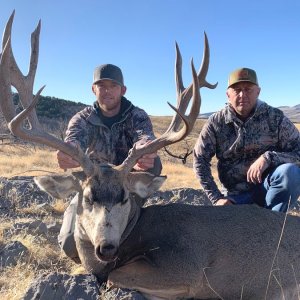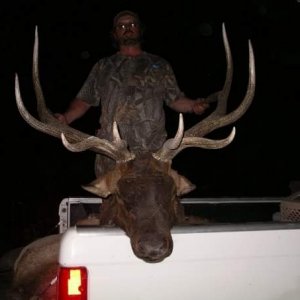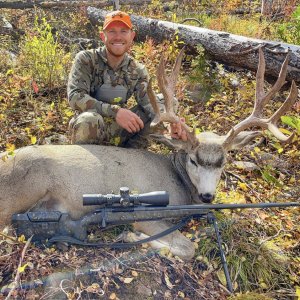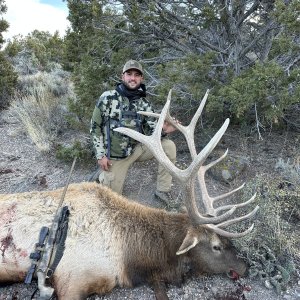Hiker of the Woods
Active Member
- Messages
- 623
I have been watching this for some time now and extremely excited to see this study finally conclude in the Pacific NW! This study used with all the studies done at Starkey Experimental http://www.fs.fed.us/pnw/starkey/along with mandatory reporting will hopefully allow ODFW to better manage our wildlife. Maybe we will get a better understanding what the carrying capacity is in Oregon for elk and deer. Here are some of the main findings from the study if people don't want to read the entire paper.
Scientists from state, federal, private, and tribal entities, led by the Pacific Northwest Research Station of the U.S. Forest Service, are developing and evaluating new elk nutrition and habitat use models for management use in Oregon and Washington. These next-generation models:
-Reflect key research findings from the last two decades, especially involving elk nutrition and foraging dynamics;
-Include a nutrition and habitat use component;
-Use innovative approaches, combined with large radio telemetry data sets from GPS collars, to predict where elk will occur across large landscapes;
-Benefit land management plan revisions and habitat management and restoration for elk across all land ownerships in Oregon and Washington; and
-Target summer range habitats, considered a key driver of elk productivity.
http://oregonforests.org/sites/defau...er_for_web.pdf
How do deer and elk interact with intensively managed Douglas-fir plantations?
Overall, herbicide applications reduced both total and palatable biomass in1- and 2-year-old units and, while biomass of unpalatable species remained suppressed after 10years, biomass of palatable species was no different from that found in untreated stands. Also in this study, forage biomass in treated regenerating stands was compared to that in mature (>60 years old) forest stands: results indicated that young treated stands contained, on average, twice as much biomass as mature stands, and in some cases biomass of palatable species was six times higher.
How important is thermal cover to deer and elk populations?
In studies conducted from 1991 to 1995 at the Starkey Experimental Forest and Range in northeastern Oregon, researchers found no measurable benefits of thermal cover in either winter orsummer. Instead, biologists found that elk held in dense cover stands during the winter lost more weight than elk held in clearcuts. Also, biologists found that during the summer there was no difference in growth of yearling elk among the different thermal cover treatments.
Similar studies were conducted for mule deer and white-tailed deer in Maine and Colorado. These studies also found that thermal cover has little influence over animal energy balance and performance.
How important are winter and summer forage for elk?
The requirements of elk vary depending on the season of the year. According to work conducted by John Cook (2002), elk require the most energy and food from midsummer through fall. During the winter their nutritional requirements drop and don't pick up again until the summer.
In moist west-side forest ecosystems, the average digestibility of forage was highest in the early years, although even during some of the early years of this study, forage in some geographies was inadequate to provide high-quality nutrition. Given the importance of summer forage, land managers may also want to consider using seed mixes in disturbed areas. Many seed mixes are available, and choosing a deer and elk-friendly mix could go a long way toward providing much-needed forage.
How has the change in management on federal forestlands impacted deer and elk distribution?
Limited timber harvest on USFS lands since the implementation of the NW Forest Plan and social, political and legal mandates associated with late successional species have resulted in less early seral habitat on large contiguous tracts of USFS lands. Deer and elk rely on these young forest habitats for foraging opportunities. The most recent elk population survey flights by ODFW were completed in most of Oregon by late February 2012. Although national forest lands account for approximately half the land base, only (13 percent) counted elk were observed on national forest lands. The rest (87 percent) were seen on privately owned timber lands (ODFW 2012).
Some biologists think that there is a distribution problem in both deer and elk herds, and that deer and elk are found too often on private lands and not often enough on federal and state lands (Don Whittaker, pers. comm., 2012).
Elk habitat selection and modeling
Excerpts from USFS-PNW Research Station summaries by Rachel White
Land managers will be the first to admit that managing the landscape with elk is challenging. Elk have multimillion-dollar effects on recreation and land management. The Elk Modeling Team, made up of multiple collaborators from the U.S. Forest Service, BLM, ODFW, WDFW, NCASI, local tribes, OSU and others, has developed new habitat-selection models in conjunction with new elk nutrition models. These new models incorporate updated research and provide a foundation for setting future management direction and habitat restoration guidelines for elk in landscapes across the Pacific Northwest. Models have been developed for both east-side (Blue Mountains) and west-side landscapes. The elk models focus on summer, a critical time for elk productivity, because summer conditions affect year-round animal performance. For example, the amount and quality of available summer forage directly affect elk pregnancy rates. Management of summer forage areas for elk is thus critical to the management of healthy elk herds, and providing foraging opportunities in summer helps elk survive winter.
This big-picture approach is designed to help landowners work to integrate management objectives and habitat treatments for elk across ownerships. The models were tested across several land ownerships including tribal, Forest Service and BLM lands in order to test real-life management scenarios.
Biologists working on the model found:
? The needs of elk are compatible with active silvicultural management. Elk generally benefit from management practices that reduce overstory cover. Use of the forage base resulting from silvicultural actions is based on the availability of nearby cover and on human disturbance levels.
? In general, forests with less-dense canopies and located at higher elevationshave more high-quality forage species for elk. Elk need high-quality summer forage to increase their body fat in order to survive the winter.
? Biologists found that most elk forage in the Coast Range and in many areasof the Cascades is relatively poor nutritionally. Even in clearcuts, where oneexpects to see more deciduous growth, forage is often below maintenance levels for lactating elk.
? Biologists found that in western Oregon and Washington, elk select gentle slopes close to forest edges that contain both hiding cover and forage, andthat are away from open roads.
If you have elk on your land, these models can help predict where the elk will be during the summer and what the available nutritional resources are like. Managers can then apply their professional judgment to manipulate these areas to increase or decrease elk use consistent with overall management objectives. For more information or to obtain the models and the user guide, visit the project website: www.fs.fed.us/pnw/research/elk
How do deer and elk respond to fuels reduction projects on federal land?
The results from this study:
? Female mule deer did not change their use of treated stands following the fuels reduction management. Female mule deer used and avoided all stand types in proportion to their availability during spring and summer months.
? During spring, female elk selected treated stands and avoided untreated stands. But during summer, female elk selected untreated stands and largely avoided treated stands.
? Female and male elk use stands differently. Biologists found that during spring, females selected older burns, but males avoided all treated stands. Additionally, untreated stands were avoided by females but selected by males during spring. During summer, however, untreated stands were selected and treated stands were avoided or used in proportion to their availability regardless of sex.
? Biologists found that both quality (in terms of nutritional value) and quantity of forage for elk were lower in summer than spring across all stand types. In particular, the reduction in canopy cover associated with fuels reduction increased the growth of quality forage in spring, but led to a more rapid aging of important forage species in summer. Responses of individual forage species to fuels reduction varied, but the total abundance of forage was higher in treated than untreated stands during spring months. The opposite was true for summer months.
Summary
Early seral vegetation provides forage and habitat for deer and elk as well as many of the other wildlife species associated with young forest habitats in Oregon. Land managers whose objectives include providing habitat and forage for deer and elk may want to consider the following silvicultural treatments:
? Where thinning is prescribed, thin timber stands to or below 50 percent crown closure to allow sufficient sunlight to reach the ground surface for early seral vegetation to become established.
? Retain any natural meadows and openings and remove encroaching conifers from these open areas. Note that power-line easements make great openings and often provide habitat for deer and elk.
? In thinned stands, create gaps of 1 to 5 acres on sites with east, south or west solar aspect and slopes less than 30 percent and away from open roads.
? In created gaps, plant a few native shrubs that provide fruit, nuts, berries or browse for wildlife.
? Seed all disturbed soil including skid trails, yarding corridors, landings and decommissioned roads with a seed mix of native grass and forb species that will provide high forage value for deer, elk and other species. These management prescriptions may not make sense for all landowners or all landscapes, but they will work in some areas to help provide habitat for deer and elk.
Scientists from state, federal, private, and tribal entities, led by the Pacific Northwest Research Station of the U.S. Forest Service, are developing and evaluating new elk nutrition and habitat use models for management use in Oregon and Washington. These next-generation models:
-Reflect key research findings from the last two decades, especially involving elk nutrition and foraging dynamics;
-Include a nutrition and habitat use component;
-Use innovative approaches, combined with large radio telemetry data sets from GPS collars, to predict where elk will occur across large landscapes;
-Benefit land management plan revisions and habitat management and restoration for elk across all land ownerships in Oregon and Washington; and
-Target summer range habitats, considered a key driver of elk productivity.
http://oregonforests.org/sites/defau...er_for_web.pdf
How do deer and elk interact with intensively managed Douglas-fir plantations?
Overall, herbicide applications reduced both total and palatable biomass in1- and 2-year-old units and, while biomass of unpalatable species remained suppressed after 10years, biomass of palatable species was no different from that found in untreated stands. Also in this study, forage biomass in treated regenerating stands was compared to that in mature (>60 years old) forest stands: results indicated that young treated stands contained, on average, twice as much biomass as mature stands, and in some cases biomass of palatable species was six times higher.
How important is thermal cover to deer and elk populations?
In studies conducted from 1991 to 1995 at the Starkey Experimental Forest and Range in northeastern Oregon, researchers found no measurable benefits of thermal cover in either winter orsummer. Instead, biologists found that elk held in dense cover stands during the winter lost more weight than elk held in clearcuts. Also, biologists found that during the summer there was no difference in growth of yearling elk among the different thermal cover treatments.
Similar studies were conducted for mule deer and white-tailed deer in Maine and Colorado. These studies also found that thermal cover has little influence over animal energy balance and performance.
How important are winter and summer forage for elk?
The requirements of elk vary depending on the season of the year. According to work conducted by John Cook (2002), elk require the most energy and food from midsummer through fall. During the winter their nutritional requirements drop and don't pick up again until the summer.
In moist west-side forest ecosystems, the average digestibility of forage was highest in the early years, although even during some of the early years of this study, forage in some geographies was inadequate to provide high-quality nutrition. Given the importance of summer forage, land managers may also want to consider using seed mixes in disturbed areas. Many seed mixes are available, and choosing a deer and elk-friendly mix could go a long way toward providing much-needed forage.
How has the change in management on federal forestlands impacted deer and elk distribution?
Limited timber harvest on USFS lands since the implementation of the NW Forest Plan and social, political and legal mandates associated with late successional species have resulted in less early seral habitat on large contiguous tracts of USFS lands. Deer and elk rely on these young forest habitats for foraging opportunities. The most recent elk population survey flights by ODFW were completed in most of Oregon by late February 2012. Although national forest lands account for approximately half the land base, only (13 percent) counted elk were observed on national forest lands. The rest (87 percent) were seen on privately owned timber lands (ODFW 2012).
Some biologists think that there is a distribution problem in both deer and elk herds, and that deer and elk are found too often on private lands and not often enough on federal and state lands (Don Whittaker, pers. comm., 2012).
Elk habitat selection and modeling
Excerpts from USFS-PNW Research Station summaries by Rachel White
Land managers will be the first to admit that managing the landscape with elk is challenging. Elk have multimillion-dollar effects on recreation and land management. The Elk Modeling Team, made up of multiple collaborators from the U.S. Forest Service, BLM, ODFW, WDFW, NCASI, local tribes, OSU and others, has developed new habitat-selection models in conjunction with new elk nutrition models. These new models incorporate updated research and provide a foundation for setting future management direction and habitat restoration guidelines for elk in landscapes across the Pacific Northwest. Models have been developed for both east-side (Blue Mountains) and west-side landscapes. The elk models focus on summer, a critical time for elk productivity, because summer conditions affect year-round animal performance. For example, the amount and quality of available summer forage directly affect elk pregnancy rates. Management of summer forage areas for elk is thus critical to the management of healthy elk herds, and providing foraging opportunities in summer helps elk survive winter.
This big-picture approach is designed to help landowners work to integrate management objectives and habitat treatments for elk across ownerships. The models were tested across several land ownerships including tribal, Forest Service and BLM lands in order to test real-life management scenarios.
Biologists working on the model found:
? The needs of elk are compatible with active silvicultural management. Elk generally benefit from management practices that reduce overstory cover. Use of the forage base resulting from silvicultural actions is based on the availability of nearby cover and on human disturbance levels.
? In general, forests with less-dense canopies and located at higher elevationshave more high-quality forage species for elk. Elk need high-quality summer forage to increase their body fat in order to survive the winter.
? Biologists found that most elk forage in the Coast Range and in many areasof the Cascades is relatively poor nutritionally. Even in clearcuts, where oneexpects to see more deciduous growth, forage is often below maintenance levels for lactating elk.
? Biologists found that in western Oregon and Washington, elk select gentle slopes close to forest edges that contain both hiding cover and forage, andthat are away from open roads.
If you have elk on your land, these models can help predict where the elk will be during the summer and what the available nutritional resources are like. Managers can then apply their professional judgment to manipulate these areas to increase or decrease elk use consistent with overall management objectives. For more information or to obtain the models and the user guide, visit the project website: www.fs.fed.us/pnw/research/elk
How do deer and elk respond to fuels reduction projects on federal land?
The results from this study:
? Female mule deer did not change their use of treated stands following the fuels reduction management. Female mule deer used and avoided all stand types in proportion to their availability during spring and summer months.
? During spring, female elk selected treated stands and avoided untreated stands. But during summer, female elk selected untreated stands and largely avoided treated stands.
? Female and male elk use stands differently. Biologists found that during spring, females selected older burns, but males avoided all treated stands. Additionally, untreated stands were avoided by females but selected by males during spring. During summer, however, untreated stands were selected and treated stands were avoided or used in proportion to their availability regardless of sex.
? Biologists found that both quality (in terms of nutritional value) and quantity of forage for elk were lower in summer than spring across all stand types. In particular, the reduction in canopy cover associated with fuels reduction increased the growth of quality forage in spring, but led to a more rapid aging of important forage species in summer. Responses of individual forage species to fuels reduction varied, but the total abundance of forage was higher in treated than untreated stands during spring months. The opposite was true for summer months.
Summary
Early seral vegetation provides forage and habitat for deer and elk as well as many of the other wildlife species associated with young forest habitats in Oregon. Land managers whose objectives include providing habitat and forage for deer and elk may want to consider the following silvicultural treatments:
? Where thinning is prescribed, thin timber stands to or below 50 percent crown closure to allow sufficient sunlight to reach the ground surface for early seral vegetation to become established.
? Retain any natural meadows and openings and remove encroaching conifers from these open areas. Note that power-line easements make great openings and often provide habitat for deer and elk.
? In thinned stands, create gaps of 1 to 5 acres on sites with east, south or west solar aspect and slopes less than 30 percent and away from open roads.
? In created gaps, plant a few native shrubs that provide fruit, nuts, berries or browse for wildlife.
? Seed all disturbed soil including skid trails, yarding corridors, landings and decommissioned roads with a seed mix of native grass and forb species that will provide high forage value for deer, elk and other species. These management prescriptions may not make sense for all landowners or all landscapes, but they will work in some areas to help provide habitat for deer and elk.

